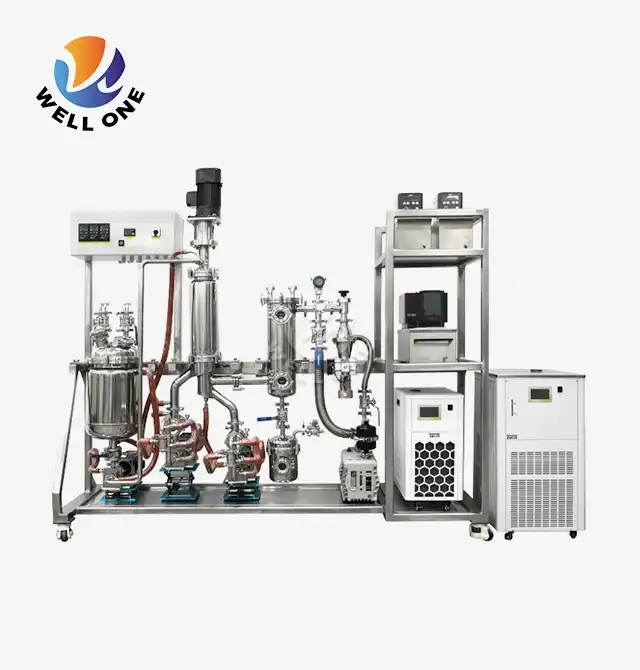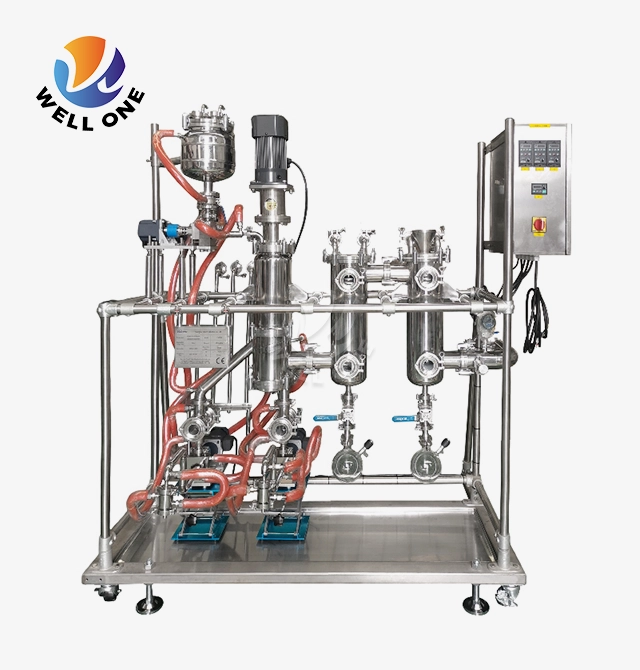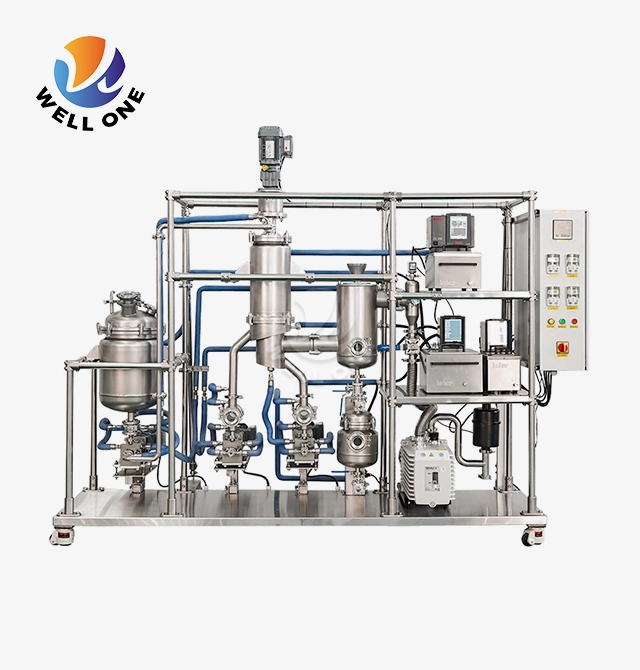How does molecular distillation equipment work?
Molecular distillation equipment is an advanced separation technology that operates on the principle of creating a thin film of liquid on a heated surface under high vacuum conditions. This process allows for the separation of molecules based on their different volatilities, even at temperatures below their boiling points. The equipment works by continuously feeding a mixture onto a heated surface, where more volatile components evaporate quickly and are collected on a nearby condenser. Less volatile components remain on the surface and are separately collected. This gentle separation method is particularly useful for heat-sensitive or easily oxidized substances, making it invaluable in various industries such as pharmaceuticals, food processing, and chemical manufacturing.
The Core Principles of Molecular Distillation
High Vacuum Environment
The high vacuum environment is a crucial aspect of how molecular distillation equipment works. Typically operating at pressures as low as 0.001 mbar, this extreme vacuum significantly lowers the boiling points of substances. This allows for separation at much lower temperatures than conventional distillation methods. In the case of Xi'an Well One Chemical Technology Co., Ltd.'s Molecular Distillation Equipment, the vacuum system consists of a vane vacuum pump (TRP-60) with a capacity of 21L/S and a turbo pump (TYFB-600) with a capacity of 600L/S. This powerful vacuum system ensures efficient separation even for thermally sensitive materials, preserving their integrity throughout the process.
Thin Film Formation
The formation of a thin film is another key principle in the operation of molecular distillation equipment. As the feed material enters the evaporator, it's distributed evenly across the heated surface, creating a film typically less than 1mm thick. This thin film is crucial for efficient separation. In Well One's WMD-30 model, the evaporator has an area of 0.3㎡ and an inner diameter of 210mm. The material is spread using either a wiper or roller scraper blade, which can rotate at speeds up to 350 rpm. This thin film maximizes the surface area for evaporation, allowing for rapid and efficient separation of volatile components from the mixture.
Short Residence Time
A short residence time is essential in molecular distillation to minimize thermal degradation of sensitive compounds. In Well One's Molecular Distillation Equipment, the combination of the thin film and the high vacuum ensures that molecules spend only a brief moment on the heated surface. The feed gear pump, capable of flow rates between 5L to 25L/H, precisely controls the input, while the discharge gear pumps for both light and heavy fractions ensure quick removal of separated components. This short exposure to heat is particularly beneficial for pharmaceutical intermediates, natural extracts, and other heat-sensitive materials, preserving their quality and efficacy throughout the separation process.
Components and Their Functions in Molecular Distillation Equipment
Evaporator and Condenser System
The evaporator and condenser system is the heart of molecular distillation equipment. In Well One's WMD-30 model, the evaporator has a surface area of 0.3㎡, while the built-in condenser boasts an area of 0.75㎡. The evaporator is where the thin film forms and separation occurs. It's heated by a sophisticated system (UC-200-5) capable of temperatures up to 300°C with a heating power of 10kW. The internal condenser, positioned close to the evaporation surface, quickly captures the vaporized molecules. This proximity minimizes the distance molecules travel, reducing the risk of recombination or degradation. The condenser is cooled by a versatile heater and chiller system (GDX-30/30+200) that can operate from -20°C to 200°C, ensuring efficient condensation of a wide range of substances.
Feed and Discharge Systems
The feed and discharge systems in molecular distillation equipment are crucial for maintaining a continuous and efficient separation process. Well One's Molecular Distillation Equipment features a 30L jacketed material tank equipped with two sight glasses for easy monitoring and an insulated ball valve at the bottom for controlled feeding. The feed gear pump, with a capacity of 5L to 25L/H, precisely controls the input rate. This pump uses variable frequency speed regulation for fine-tuning the flow. On the output side, two separate discharge gear pumps (each 5L to 25L/H) handle the light and heavy fractions respectively. These pumps ensure that both the distillate and the residue are quickly removed from the system, maintaining the efficiency of the separation process and preventing any backflow or mixing of separated components.
Vacuum and Cooling Systems
The vacuum and cooling systems are integral to the operation of molecular distillation equipment. Well One's system employs a two-stage vacuum setup: a vane vacuum pump (TRP-60) with a capacity of 21L/S, coupled with a turbo pump (TYFB-600) capable of 600L/S. This combination can achieve an impressive vacuum level as low as 0.001 mbar, essential for lowering boiling points and enabling gentle separation. The cooling system is equally sophisticated, featuring a chiller for the external condenser (DSLB-20/80) that can reach temperatures as low as -80°C. This extreme cooling capacity ensures efficient condensation of even highly volatile compounds. Additionally, the system includes a cold trap (C01) to capture any trace molecules that might escape the main condenser, protecting the vacuum pump and preventing environmental contamination. These systems work in concert to create the ideal conditions for molecular separation, making the equipment suitable for a wide range of applications from pharmaceutical intermediates to food-grade oils.
Applications and Advantages of Molecular Distillation
Pharmaceutical Applications
Molecular distillation equipment plays a crucial role in the pharmaceutical industry, particularly in the synthesis and purification of pharmaceutical intermediates and monomers. The gentle separation process of Well One's Molecular Distillation Equipment is ideal for refining plant-extracted drugs and fermentation pharmaceutical intermediates. The equipment's ability to operate at low temperatures (below boiling points) and high vacuum (down to 0.001 mbar) makes it perfect for handling thermally sensitive compounds without degradation. For instance, in the production of certain antibiotics or steroids, molecular distillation can separate and purify key intermediates with high efficiency and minimal thermal stress. The equipment's 316L stainless steel construction ensures compatibility with a wide range of pharmaceutical compounds, while its CE, ISO, UL, and ATEX certifications guarantee compliance with international pharmaceutical manufacturing standards.
Food Industry Applications
In the food industry, molecular distillation equipment is extensively used for processing and refining various oils and nutritional compounds. Well One's Molecular Distillation Equipment is particularly suited for producing high-quality MCT oil, walnut oil, sea buckthorn seed oil, and other specialty oils. The equipment's precise temperature control and high vacuum capabilities allow for the concentration of heat-sensitive nutrients like vitamin E and carotene without degradation. For example, in fish oil processing, molecular distillation can effectively remove contaminants and concentrate omega-3 fatty acids, resulting in a purer, more potent product. The equipment's ability to handle viscous liquids and its high evaporation area (0.3㎡ in the WMD-30 model) ensure efficient processing of various food-grade oils. Moreover, the system's compliance with food safety standards makes it an ideal choice for producing high-quality, food-grade ingredients.
New Materials and Petrochemical Applications
Molecular distillation equipment finds extensive use in the new materials and petrochemical industries. Well One's equipment is particularly adept at processing and refining substances such as epoxy resins, liquid crystal materials, and OLED materials. In the petrochemical sector, it's used for refining polyol cool lubricating oils, silicone oils, and even regenerating waste lubricating oils. The equipment's high vacuum capability (down to 0.001 mbar) and precise temperature control (up to 300°C in the WMD-30 model) allow for the separation of closely related compounds that might be impossible with traditional distillation methods. For instance, in the production of high-temperature heat transfer oils or aviation lubricating oils, molecular distillation can remove impurities and achieve the exact molecular weight distribution required for optimal performance. The equipment's versatility is further enhanced by its ability to handle both small-scale (30L tank in WMD-30) and larger industrial processes, making it suitable for both research and production applications in these cutting-edge industries.
Conclusion
Molecular distillation equipment represents a pinnacle in separation technology, offering unparalleled precision and gentleness in processing sensitive materials. Its ability to operate at low temperatures under high vacuum makes it indispensable across various industries, from pharmaceuticals to petrochemicals. The technology's versatility and efficiency in handling complex mixtures position it as a crucial tool in modern industrial processes. At Xi'an Well One Chemical Technology Co., Ltd., we pride ourselves on delivering top-quality molecular distillation equipment tailored to your specific needs. With 17 years of expertise in this field, we offer not just equipment, but comprehensive solutions including OEM & ODM services. Our team of skilled engineers can provide custom 3D designs and animations to perfectly match your requirements. Experience the difference that comes with choosing a leader in the industry. For more information or to discuss your specific needs, please contact us at info@welloneupe.com. Let's work together to elevate your separation processes to new heights of efficiency and quality.
References
1. Smith, J.D. & Johnson, M.R. (2019). Advances in Molecular Distillation Technologies for Pharmaceutical Applications. Journal of Separation Science, 42(15), 3102-3115.
2. Chen, L., Wang, X., & Zhang, H. (2020). Molecular Distillation in the Food Industry: Current Status and Future Prospects. Trends in Food Science & Technology, 103, 160-171.
3. Patel, R.N. & Suresh, A.K. (2018). Molecular Distillation: A Review of Recent Developments and Applications. Separation and Purification Reviews, 47(3), 179-196.
4. García-Sánchez, F., et al. (2021). Optimization of Molecular Distillation Parameters for Essential Oil Extraction: A Comprehensive Review. Industrial & Engineering Chemistry Research, 60(10), 3890-3905.
5. Yoshida, H. & Takahashi, Y. (2017). Molecular Distillation for Various Industrial Applications. In Distillation - Innovative Applications and Modeling (pp. 149-178). IntechOpen.
6. Li, W., Zhao, C., & Tan, Z. (2022). Recent Progress in Molecular Distillation Technology for New Materials Processing. Chemical Engineering Journal, 430, 132957.







